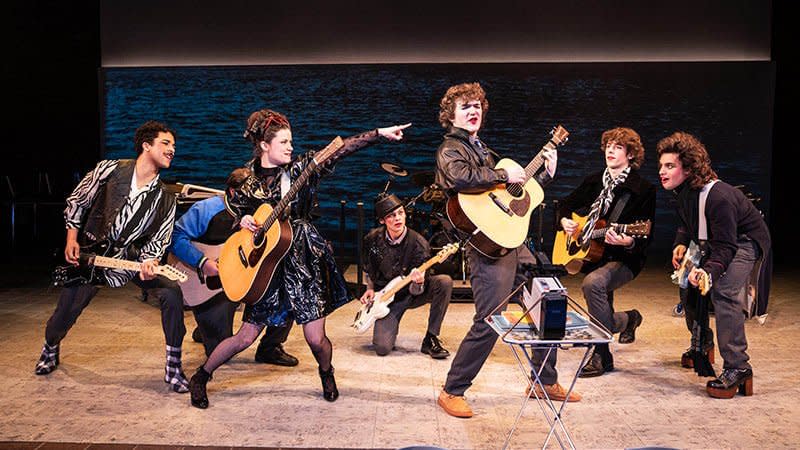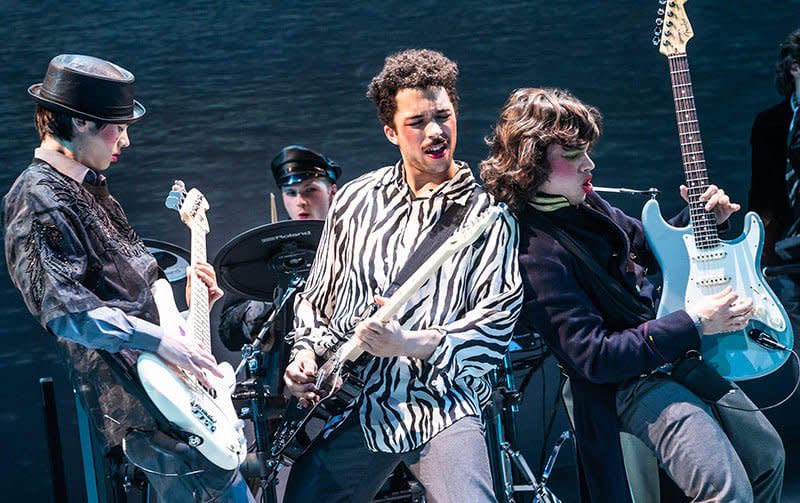If You Love 1980s British Pop Music and ‘Once,’ You Will Love ‘Sing Street’

It is tough not to see traces of Once when you watch Sing Street. Both musicals are derived from films written and directed by John Carney (Once in 2007, Sing Street in 2016). Both have a charming, sweetly nervy heterosexual love story at their center: Guy and Girl in Once; and Conor (Brenock O’Connor) and Raphina (Zara Devlin) in Sing Street.
Both are set in Dublin (Sing Street in 1982), and both have wonderful music and songs—the work of Carney, with Gary Clark, in Sing Street. And both started their New York lives at the New York Theater Workshop, where Sing Street opens Monday night (to Jan. 26, 2020). The unanswered question: Will Sing Street follow Once to Broadway?
Alanis Morissette Conquers Broadway With Brilliant, Powerful ‘Jagged Little Pill’ Jukebox Musical
In its favor, the musical, directed with lots of energy and wit by Tony-winning Rebecca Taichman, is set in the ever-popular 1980s. It comes out swinging with a brilliant build-as-it-comes version involving the whole company of Depeche Mode’s “Just Can’t Get Enough.”
The musical mixes pop songs from the era with original songs. Martin Lowe oversees the orchestrations and arrangements so well that any 1980s music buff may wonder: Wait, is that an original song, or an obscure ’80s one I don’t know about? Oh mighty, mighty synth, you beautiful thing.
Where Once was about adults, Sing Street is about teenagers. Its name is the name of a boys’ band (taken from Synge Street, the name of their school). In some ways, it’s a traditional story of a group of lovable rapscallions (led by Max William Bartos as a wannabe Svengali) getting together to storm the charts, costumed in the gender-blurring garb of the early 1980s.
Bob Crowley’s fabulous costumes and J. Jared Janas’ just-as-fabulous makeup will summon up images of Culture Club, Haircut 100, Heaven 17, and The Human League. The hair is big, the cheeks a rainbow of colors, and the boys want to know what shade of lipstick and eyeshadow works best for them. Jakeim Hart, Bartos, Devlin, Sam Poon, O’Connor, Brendan C. Callahan, and Gian Perez are formidable and fun to watch, as they ape ’80s pop singing and dancing styles pretty near perfectly.

(l to r) Sam Poon, drummer Anthony Genovesi, Jakeim Hart, and Gian Perez in “Sing Street.”
Carney and book writer Enda Walsh both grew up in Dublin in the 1980s, and so know the themes of the play, big and small, all too well. Bob Crowley’s scenic design is spartan, allowing spaces to shift between home and school with the addition of a mattress here and desk there. But the key design component is a roiling projection of the Irish Sea behind the actors; it symbolizes the exodus of Irish people to England for better-paid jobs and lives, which the play notes in its opening lines.
The other significant theme of Sing Street is the specter of religious repression, as represented by Brother Baxter, the head teacher of the comprehensive school Conor must now attend, after his family finances have run dry enough to mean he can’t attend a fee-paying establishment.
Martin Moran as Baxter—out to stop the music, stop the fun, and all the young folks’ self-expression—is the most compelling actor on stage, plausibly and even sympathetically sketching the meaning and past pain and bitterness behind Baxter’s sadism and cruelty. This critic felt quite sorry, rather than cheering, as the youngsters meted out their final high-volume revenge on Baxter. It felt like, as played by Moran, he deserved a final redemption chapter.
Carney and Walsh stud the main drama with solid incidental dramatic decoration, like Brendan (Gus Halper), Conor’s brother, hiding his own pain and love for his brother, band member Gary’s (Callahan) determination to grow a mustache, and Anne L. Nathan as a protective, welcoming mother, who should have more to say and do.
The play feels more sure in its music and levity and less in welding the agonized arcs of its domestic and religious dramas, either making family rows too loud or too short. The emotional stakes do not feel knife-edge, and the compulsion for the two young leads to head across the Irish Sea isn’t convincingly sketched either. A bully-with-a-secret storyline flares unevenly in and out of life.
But Sing Street, like Once, has a seductive, galvanizing energy rooted in its music, the complementary charms of O’Connor and Devlin, and tortured animus of Moran. Conor and Raphina’s love story is not sugary but spiky and fascinating, as we watch two people grow to know each other rather than just become hostages to the usual dramatic sappiness. One of the cutest moments is when Conor, desperate to kiss Raphina, insists he can wait while she concludes the important task of finishing her digestive biscuit.
Christopher Akerlind’s lighting of their romance serves up one of the best stage illuminations this critic has seen all year: a sky filled with stars, set down on earth. And yes, this critic thought later, that special effect would look stunning on Broadway.
Get our top stories in your inbox every day. Sign up now!
Daily Beast Membership: Beast Inside goes deeper on the stories that matter to you. Learn more.

